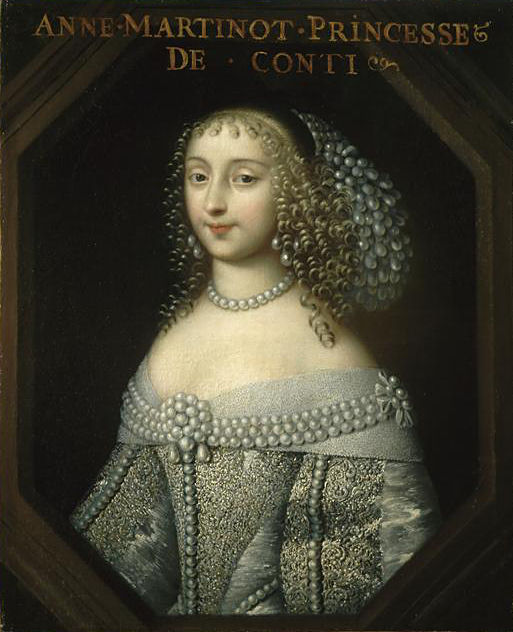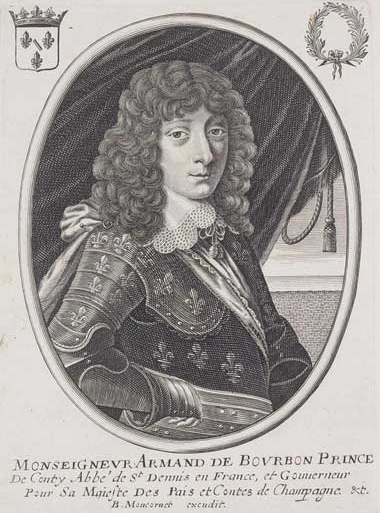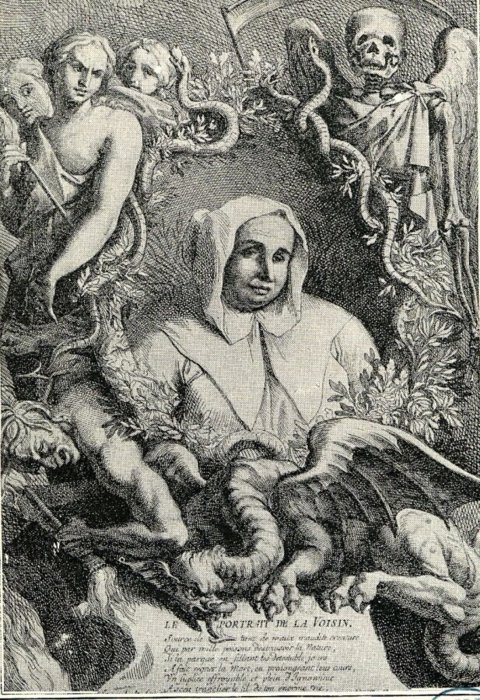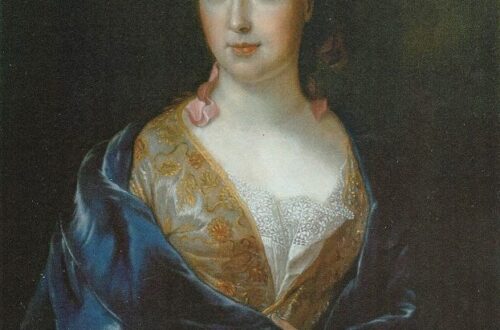Anne-Marie Martinozzi, Princesse de Conti
Born in 1637, as youngest daughter of Comte Girolamo Martinozzi and Laura Margherita Mazzarini, sister of Cardinal de Mazarin, Anne-Marie came to France in 1648 together with her mother and sister Laura. Mother and daughters lived first at Aix-en-Provence, then in the Palace of her brother and finally settled at the court of Anne d’Autriche, in the apartment of the Marquise de La Rochefoucauld. Anne d’Autriche personally took care of the education of the girls and brought them up along with her own sons, the young Louis XIV and his brother Philippe.

The Cardinal meant for his nieces to marry well, preferably Ducs and Princes, in order to this establish himself and his family in France and to bring them on the same level as the Grands, the oldest and most powerful families of France. The Grands on the other hand, were quite opposed to the Cardinal’s plan, after all his family came from the midst of the Italian bourgeoisie and somehow managed, with the help of powerful patrons, to get hold of titles of the Church and marry into the Italian noblesse. Not something a Grand would wish the family tree of his heir’s bride to look like.
Mazarin, however, was Premier Minister and in possession of a fortune he was willed to spend on the dowry of his nieces. Laura Martinozzi, Anne-Marie’s older sister, was the first to be engaged and the match the Cardinal secured for her could not be better, it was Alfonso IV d’Este, the heir to the Duchy of Modena. The Cardinal aimed not less high for Anne-Marie, the chosen groom this time the Duc de Candale, heir of the House of Èpernon, and grandchild of Henri IV. His father had married one of the many illegitimate daughters of le bon Roi Henri. Anne-Marie, as good as engaged, entered a cloister to prepare for her marriage and upon leaving it in 1655, aged sixteen, expected the enter wedlock swiftly…. but the Duc de Candale was not in quite the hurry and preferred to spent his time otherwise, with feuds and in company of every other lady but Anne-Marie.
A new possible husband had to be found, since the first one seemed so shy to enter wedlock suddenly, and the Cardinal, with Laura now married, aimed a little higher. He contacted Armand de Bourbon, a Prince du Sang. Armand held the title of Prince de Conti, bestowed upon him at his birth in 1629, and was a Frondeur who had spent some time in prison, where he was said to have turned quite mad. He was an unmarried Prince of the Blood, with not much of a fortune and not really good-looking either, but there was the possibility of one of his nieces becoming Princess of the Blood by marriage… reason enough.
Armand agreed to marry one of the Cardinal’s nieces and did not really care which one. The dowry was the important thing. The Cardinal was thrilled. The Prince de Conti was given the choice between Olympe Mancini and Anne-Marie, his plenipotentiary deems the blonde Anne-Marie more beautiful and thus the matter is agreed on. The Duc de Candale is persuaded to give up his engagement, which requires not much effort. He died a year later, due to a strange fever. The females at court mourned him and Anne-Marie, now a celebrated court beauty, entered wedlock.

She wore black for the engagement ceremony, not because she mourned as well, but because black is the best background colour to show of the Cardinal’s diamonds he had adorned her with. The wedding took place in the Louvre on the next day, 22 February 1654, with Anne-Marie wearing expensive brocatelle and an enormous amount of shimmering pearls. It was the event of the season and the celebrations as opulent as they could be. The Cardinal payed for everything, including a remodelling of the Hôtel de Conti, the new home of his niece.
What started with a fairy-tale wedding, soon became less fairy-tale. Anne-Marie’s husband seemed to regret the marriage and distanced himself from his beautiful wife. It was rumoured the reason for it is called Anne-Geneviève de Bourbon, wife of Henri II d’Orléans, a legitimated Prince of France. Anne-Geneviève was the sister of Marie-Anne’s husband Armand and rumour had it, both of them were connected in a “strange way” since childhood. Armand spent more and more time away from his wife, while she enjoyed the life at court and her freedom, along with her sisters and cousins, who now belonged to the creme de la creme of society, due to Anne-Marie having become a Princesse de Sang by marriage.
Anne-Marie began to tire suddenly of court life around 1660 and transformed from charming court beauty with many admirers, to a quiet and introverted person after an illness that nearly put her into the grave. From then on the Princesse de Conti hardly visited the exciting activities at court anymore and turned towards religion. It was the time of the Jansenism, a Catholic theological movement, primarily in France, that emphasised original sin, human depravity, the necessity of divine grace, and predestination. Anne-Marie became a dedicated follower. She even convinced her husband, who still showed more interest in his sister than his wife, of her new-found religious stance and both, husband and sister, join her in her mission to aid the sick and poor.
She gave birth to her first child on 6 September 1658, a son baptised Louis de Bourbon, who died only eight days later. Another son, Louis-Armand de Bourbon, followed on 4 April 1661, and died childless aged twenty-four in 1685. Three years later, on 30 April 1664, Anne-Marie gave birth to a third son and her last child, François-Louis de Bourbon. He and his wife Marie-Thérèse de Bourbon became the titular monarchs of Poland in 1697.
Anne-Marie was widowed in 1666 and the title of Prince de Conti passed to her second born son Louis-Armand de Bourbon. She spent the rest of her life devoted to religion, study, mysticism, and hardly made an appearance at court, with a few exceptions, for example as she acted as godmother by proxy to Louis de France, le Grand Dauphin, for Henriette-Marie de France, widow of Charles I of England.
Anne-Marie died at the Hôtel the Conti in Paris, aged thirty-five, on February 4, 1672.
Her last born son, François-Louis de Bourbon, inherited the title Prince de Conti in 1685, and had several affairs with both men and females, his descendants include Louis-Philippe I, King of the French and the present-day pretenders to the Throne of France and Italy as well as the Kings of Spain and Belgium.




